Whether you're a single person or a large city, make sure your waste is not wasted.
Worship the Gods, please the Earth Back

Temples are places where devotees gather to pay offerings to the gods. Once the rituals of offering flowers, fruits or milk are over and the prasad is distributed, devotees return home satisfied. But what happens to these offerings at the temple? Don’t they become waste and pollute the environment?
This is the question that environmentalist Mangalam Balasubramanian has been asking. As the founder of Exnora Green Pammal (EGP), an organization advocating responsible solid waste management in the town of Pammal in Tamil Nadu, the waste created at temples has been on her mind. “I have been concerned about temple cleanliness since most of our small temples are littered with prasad leftovers and flower offerings in a very unhygienic manner,” says Balasubramanian. Concerned about this state of affairs, she came up with the Temple Green Project.
As part of this project, the organic waste generated at temples is now disposed off in a responsible and eco-friendly way. With the help of EGP, two temples in Pammal, namely Arulmigu Aarkeswarar and Suriamman Temple, and Vinayaka Temple, reuse the waste they create. They have set up biogas plants that utilize leftover flowers, fruits and other organic offerings to produce biogas, which is used for making prasad at the temple itself.
This inexpensive technology has also helped the temple to conserve its resources, says Balasubramanian. “Temples buy LPG cylinders at commercial rates, which work out to Rs 1,500–Rs 2,000 per cylinder. However, by installing a biogas plant with the capacity of 2 cubic metres, a temple can generate 2 cubic metres of biogas, which is equivalent to 1 kg LPG gas. This is sufficient to make prasad for its devotees.”
But what, we might ask, happens to the effluents released by the biogas plant? Balasubramanian has the answer: “The sludge coming from outlet of the biogas plant can be used as manure in the temple garden and the flowers for pooja could be taken from here.”
There you have it: the model for an ecologically-friendly, zero-waste temple. The gods would be very happy indeed.